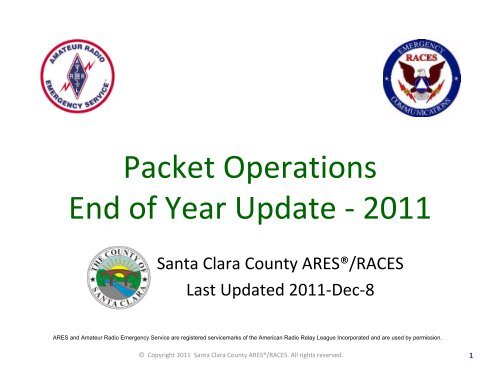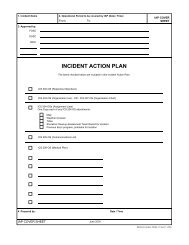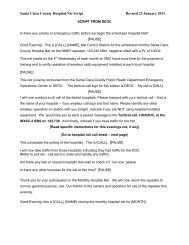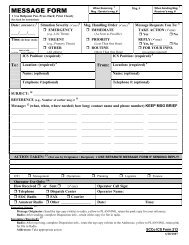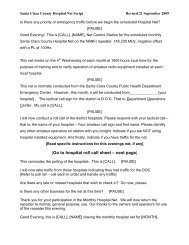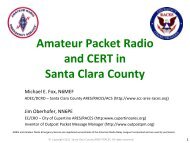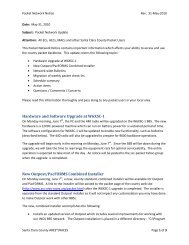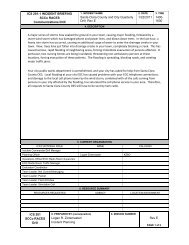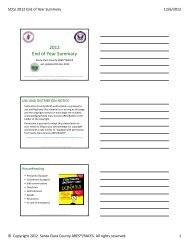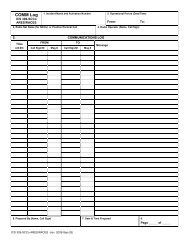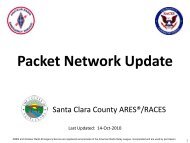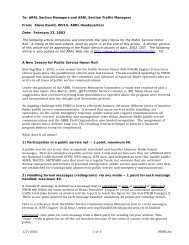2011 Year End Summary - Santa Clara County Ares/Races
2011 Year End Summary - Santa Clara County Ares/Races
2011 Year End Summary - Santa Clara County Ares/Races
Create successful ePaper yourself
Turn your PDF publications into a flip-book with our unique Google optimized e-Paper software.
Packet Operations<br />
<strong>End</strong> of <strong>Year</strong> Update ‐ <strong>2011</strong><br />
<strong>Santa</strong> <strong>Clara</strong> <strong>County</strong> ARES®/RACES<br />
Last Updated <strong>2011</strong>‐Dec‐8<br />
ARES and Amateur Radio Emergency Service are registered servicemarks of the American Radio Relay League Incorporated and are used by permission.<br />
© Copyright <strong>2011</strong> <strong>Santa</strong> <strong>Clara</strong> <strong>County</strong> ARES®/RACES. All rights reserved. 1
Why Packet Radio?<br />
• It’s fast<br />
– Yes, that’s right. Fast.<br />
– 80+ messages sent/received, logged, acknowledged, printed in<br />
triplicate, perfectly legible, in < 2 hrs, with 0 errors, by 1 person!<br />
• It’s easy<br />
– Hardware: pre‐built cables; straight‐forward connections<br />
– Software: if you can use e‐mail, you can use Outpost<br />
– Procedures: extensive documentation on website<br />
• It’s deployable<br />
– Virtually anywhere in the county and most of surrounding<br />
counties; no specialized radios or antennas required<br />
• It fits our served agencies’ needs<br />
– Preferable for long, complex, and/or high volume messages;<br />
explicit acknowledgements and tracking<br />
© Copyright <strong>2011</strong> <strong>Santa</strong> <strong>Clara</strong> <strong>County</strong> ARES®/RACES. All rights reserved. 2
Learning Objectives<br />
Our goal today is not to teach packet, but to highlight<br />
recent changes and reinforce certain key points.<br />
By the end of the class, you will be able to:<br />
•Describe the SCCo packet network structure<br />
• Understand the use of primary & secondary BBSs<br />
• Understand the use of tactical calls<br />
• Properly address messages to users in the SCCo<br />
packet network<br />
• Properly address messages to users outside the SCCo<br />
packet network<br />
© Copyright <strong>2011</strong> <strong>Santa</strong> <strong>Clara</strong> <strong>County</strong> ARES®/RACES. All rights reserved. 3
Agenda<br />
• Network Structure<br />
• Primary and Secondary BBSs<br />
•Tactical Call Signs<br />
•Packet Message Addressing<br />
•New Gateway Features<br />
© Copyright <strong>2011</strong> <strong>Santa</strong> <strong>Clara</strong> <strong>County</strong> ARES®/RACES. All rights reserved. 4
W6XSC NETWORK STRUCTURE<br />
© Copyright <strong>2011</strong> <strong>Santa</strong> <strong>Clara</strong> <strong>County</strong> ARES®/RACES. All rights reserved. 5
W6XSC BBS Locations<br />
W6XSC‐4<br />
W6XSC‐3<br />
W6XSC‐1<br />
W6XSC‐2<br />
Also: W6XSC‐5<br />
Training/Extra BBS<br />
Location Varies<br />
© Copyright <strong>2011</strong> <strong>Santa</strong> <strong>Clara</strong> <strong>County</strong> ARES®/RACES. All rights reserved. 6
BBS Physical Installation<br />
© Copyright <strong>2011</strong> <strong>Santa</strong> <strong>Clara</strong> <strong>County</strong> ARES®/RACES. All rights reserved. 7
Block Diagram: Typical W6XSC BBS<br />
8
W6XSC Connectivity/Frequencies<br />
• 144 MHz ‐ access<br />
– User access; typically individuals, some EOCs<br />
• 220 MHz ‐ access<br />
– User access; typically EOCs, some individuals<br />
– Future: add forwarding to traditional BBS network<br />
• 440 MHz ‐ forwarding<br />
– Forwarding between BBSs, no user access<br />
– Each BBS can reach all other BBSs directly<br />
• 5.8 GHz (unlicensed)<br />
– Remote access for management/maintenance<br />
– Future: use for forwarding between BBSs<br />
• Internet<br />
– Internet gateway functions currently located at Crystal Peak<br />
© Copyright <strong>2011</strong> <strong>Santa</strong> <strong>Clara</strong> <strong>County</strong> ARES®/RACES. All rights reserved. 9
W6XSC BBS Operational Concepts<br />
• The network is run like a commercial network<br />
– ARES/RACES –missing the point unless it works in an emergency<br />
– UPS, backup generators, physical and network security<br />
– Testing, automated monitoring, user communications<br />
• All BBSs have equivalent functionality, user interface<br />
– Simplifies user training<br />
– Provides backup in case of failure<br />
• All cities/agencies can reach at least 2 BBSs<br />
– Designated primary & secondary<br />
– Everyone in other cities knows where to find you<br />
• All users in a city/agency use the same BBS<br />
– Simplifies addressing<br />
– Everyone in other cities knows where to find you<br />
© Copyright <strong>2011</strong> <strong>Santa</strong> <strong>Clara</strong> <strong>County</strong> ARES®/RACES. All rights reserved. 10
Connectivity Beyond <strong>County</strong> Borders<br />
•Bay Area / ARRL Silicon Valley Section<br />
–All surrounding counties and Coastal Region EOC can reach<br />
at least one <strong>Santa</strong> <strong>Clara</strong> <strong>County</strong> BBS –no Internet<br />
required!<br />
• CalEMA Coastal Region, Alameda <strong>County</strong>, Contra Costa <strong>County</strong>,<br />
Marin <strong>County</strong>, Monterey <strong>County</strong>, San Benito <strong>County</strong>, San Francisco<br />
<strong>County</strong>, San Mateo <strong>County</strong>, <strong>Santa</strong> Cruz <strong>County</strong><br />
– Tactical calls already installed in all SCCo BBSs<br />
– Anticipated use: mutual aid; connectivity to CalEMA<br />
Coastal Region for escalation<br />
–Next Step: establish regular “check‐in” process with<br />
surrounding counties.<br />
11
Connectivity Beyond <strong>County</strong> Borders<br />
•Wide Area<br />
– AMPRnet gateway<br />
• Connectivity between amateur packet stations around the world<br />
•Uses 44/8 IP addresses, IP/IP tunnels<br />
•Working now<br />
–E‐Mail gateway<br />
• Connectivity between packet and e‐mail<br />
• Outbound is working now<br />
• Inbound coming soon; some restrictions due to Part 97<br />
–Traditional BBS network connection via RF –early 2012<br />
<strong>Santa</strong> <strong>Clara</strong> <strong>County</strong><br />
Packet Network<br />
Gateway<br />
Internet<br />
© Copyright <strong>2011</strong> <strong>Santa</strong> <strong>Clara</strong> <strong>County</strong> ARES®/RACES. All rights reserved. 12
<strong>Summary</strong> of Changes in <strong>2011</strong><br />
• Jan, <strong>2011</strong><br />
– BBS names changes to W6XSC‐# format<br />
– Moved 6 agencies from W6XSC‐1 to W6XSC‐2<br />
– New PKTMON and PKTTUE tactical calls for weekly check‐in<br />
• Mar, <strong>2011</strong><br />
– 2m access frequency change at W6XSC‐1<br />
– New W6XSC‐4 BBS at Frazier Peak<br />
• May, <strong>2011</strong><br />
– SCCo Packet Installer v31<br />
• Launch PacFORMS from Outpost; auto message #s in PacFORMS<br />
• Duplicate bulletin suppression<br />
•Improved channel efficiency (skip “LM” if no new messages)<br />
•Locked “From” field<br />
•New “Draft” designation (if “Save” in Out Tray, instead of “Send”)<br />
• Prefill PacFORMS with message number, operator info<br />
•Improved channel efficiency (don’t send blank fields)<br />
•Automatic default browser detection<br />
© Copyright <strong>2011</strong> <strong>Santa</strong> <strong>Clara</strong> <strong>County</strong> ARES®/RACES. All rights reserved. 13
<strong>Summary</strong> of Changes in <strong>2011</strong><br />
• Nov, <strong>2011</strong><br />
– AMPRnet gateway<br />
– E‐mail gateway (outbound)<br />
• All changes announced to scc‐packet Yahoo group<br />
• All changes documented on packet page of county website<br />
– www.scc‐ares‐races.org/packet.html<br />
© Copyright <strong>2011</strong> <strong>Santa</strong> <strong>Clara</strong> <strong>County</strong> ARES®/RACES. All rights reserved. 14
How do I connect?<br />
ACCESSING THE NETWORK<br />
© Copyright <strong>2011</strong> <strong>Santa</strong> <strong>Clara</strong> <strong>County</strong> ARES®/RACES. All rights reserved. 15
Antenna / Power Considerations<br />
•Packet networks are simplex<br />
•You must be able to hear EVERYONE else on the<br />
channel and they must ALL be able to hear you<br />
–If not, you WILL cause doubles<br />
–Even if the BBS can hear your HT set on 1 watt with a<br />
rubber duck antenna in the basement, the person two<br />
cities away from you can not!<br />
–Even if it works when the channel is quiet, you WILL cause<br />
doubles during a real incident (or a drill or public service<br />
event) when everyone is trying to connect<br />
• Raise your antenna as high as possible<br />
• Use plenty of power<br />
© Copyright <strong>2011</strong> <strong>Santa</strong> <strong>Clara</strong> <strong>County</strong> ARES®/RACES. All rights reserved. 16
W6XSC BBS Access Frequencies<br />
• www.scc‐ares‐races.org<br />
– Packet > Packet Frequencies and BBS Listings<br />
http://www.scc‐ares‐races.org/freqs/packet‐freqs.html<br />
• Recommendations<br />
– EOCs use 220 access (less crowded, eases EOC antenna limitations)<br />
– Individuals use 2m access (more radio/antenna options)<br />
– Always connect to your primary BBS, if available; else, use secondary<br />
© Copyright <strong>2011</strong> <strong>Santa</strong> <strong>Clara</strong> <strong>County</strong> ARES®/RACES. All rights reserved. 17
Primary & Secondary BBSs<br />
•Each city/agency has a primary and secondary BBS<br />
– Selection based on RF coverage, load<br />
•All individuals use the same BBS as their city/agency<br />
• Use primary if possible; otherwise, use secondary<br />
• Why?<br />
– Simplifies sending a message to someone<br />
–Best RF coverage for most locations in the city/agency<br />
footprint<br />
–No need to forward intra‐agency messages between BBSs<br />
– Distributes load across all BBSs<br />
•If primary fails, cities/agencies on that BBS are<br />
distributed across remaining three BBSs<br />
– Keeps load distributed, even during a failure<br />
© Copyright <strong>2011</strong> <strong>Santa</strong> <strong>Clara</strong> <strong>County</strong> ARES®/RACES. All rights reserved. 18
Primary & Secondary BBSs<br />
• Primary and Secondary BBSs are listed on the website<br />
http://www.scc‐ares‐races.org/freqs/packet‐freqs.html<br />
© Copyright <strong>2011</strong> <strong>Santa</strong> <strong>Clara</strong> <strong>County</strong> ARES®/RACES. All rights reserved. 19
Primary & Secondary BBSs<br />
• In an emergency, web site may not be available<br />
• The same information is also posted in a bulletin on all BBSs<br />
– Currently located in the “perm” area.<br />
– Bulletin area name will probably change in the next few months<br />
• Keep a copy in your Outpost “Archive” folder at all times<br />
– You may also want to save it as a text file on your PC<br />
• Post it at your EOC or operating position<br />
© Copyright <strong>2011</strong> <strong>Santa</strong> <strong>Clara</strong> <strong>County</strong> ARES®/RACES. All rights reserved. 20
Outpost: Setup > Identification<br />
• Individuals use their FCC call sign<br />
– Outpost sets TNC automatically when you set your call sign in the<br />
Station Identification screen<br />
– Alternatively: Set your TNC “mycall” with your FCC call sign; then<br />
“connect w6xsc‐#” (where # = 1‐5); TNC sends your call sign<br />
© Copyright <strong>2011</strong> <strong>Santa</strong> <strong>Clara</strong> <strong>County</strong> ARES®/RACES. All rights reserved. 21
Outpost: Setup > BBS<br />
• Select your primary BBS<br />
– Outpost SCC is preconfigured with all five W6XSC BBSs<br />
© Copyright <strong>2011</strong> <strong>Santa</strong> <strong>Clara</strong> <strong>County</strong> ARES®/RACES. All rights reserved. 22
TACTICAL CALL SIGNS<br />
© Copyright <strong>2011</strong> <strong>Santa</strong> <strong>Clara</strong> <strong>County</strong> ARES®/RACES. All rights reserved. 23
Review: FCC vs. Tactical Call Signs<br />
• FCC Call Sign<br />
– Assigned by FCC<br />
– Used to identify an amateur operator or its station<br />
– Part 97: “each amateur station … must transmit its assigned call<br />
sign … at the end of each communication, and at least every ten<br />
minutes during a communication.”<br />
• Tactical Call Sign<br />
– Assigned by net control or other local authority<br />
– Used to identify a function or a location<br />
• “Staging”, “EOC”, “Fire Station 1”<br />
– Use to call another function/location or answer a call<br />
• Using both for packet –just like for voice<br />
– Connect using tactical calls, send messages to tactical calls<br />
– Final ID with FCC call sign<br />
© Copyright <strong>2011</strong> <strong>Santa</strong> <strong>Clara</strong> <strong>County</strong> ARES®/RACES. All rights reserved. 24
What Are Tactical Call Signs?<br />
•Call sign used to identify a function or location,<br />
instead of the individual assigned there<br />
•Examples:<br />
–<strong>Santa</strong> <strong>Clara</strong> <strong>County</strong> EOC<br />
– Good Samaritan Hospital<br />
– Mountain View Varsity Park CERT<br />
–Packet Check‐in Net Control for Monday or Tuesday<br />
•Each is assigned a 6 letter abbreviation<br />
•Does not replace FCC call sign<br />
– You must still configure your FCC call sign<br />
– Outpost automatically IDs with FCC call sign at the end of a<br />
connection if a tactical call sign is used<br />
© Copyright <strong>2011</strong> <strong>Santa</strong> <strong>Clara</strong> <strong>County</strong> ARES®/RACES. All rights reserved. 25
Tactical Call Usage<br />
• When should I connect using a tactical call?<br />
–Real incidents; drills, public service events, too<br />
–Only when you are operating as that function/location<br />
–Examples:<br />
•When you are the packet operator for your city EOC<br />
•When you are the packet operator for your CERT group<br />
•When you are the packet operator for a shelter<br />
•When you are the packet check‐in net control operator<br />
– Otherwise, just connect using your FCC call sign<br />
•Which tactical call should I use?<br />
–It depends on your organization and assignment<br />
– Usually assigned by your city/agency EC, or county DEC<br />
© Copyright <strong>2011</strong> <strong>Santa</strong> <strong>Clara</strong> <strong>County</strong> ARES®/RACES. All rights reserved. 26
Tactical Call Usage<br />
• How do I know which tactical calls to send TO?<br />
– City/agency main tactical calls are posted as a bulletin to all BBSs<br />
• They’re easy enough to get for legitimate users, but we don’t post them publicly<br />
– Your city/agency has a list of their own additional tactical calls<br />
– All tactical calls for a given agency start with the same prefix<br />
– All tactical calls with the same prefix have the same primary BBS<br />
CENSORED<br />
Please do NOT send “test” messages to tactical calls. They do not need to be tested.<br />
© Copyright <strong>2011</strong> <strong>Santa</strong> <strong>Clara</strong> <strong>County</strong> ARES®/RACES. All rights reserved. 27
Tactical Call Example<br />
•In the examples that follow, we will use the mythical<br />
city of “Xanadu”<br />
• Xanadu’s main tactical call entry would look like:<br />
• Xanadu has other tactical calls which all start with<br />
the “XND” prefix:<br />
–Example: XNDFS1 = Xanadu Fire Station 1<br />
Your EC can request a list of tactical calls for your city/agency.<br />
Follow the procedure on www.scc‐ares‐races.org/packet.html.<br />
© Copyright <strong>2011</strong> <strong>Santa</strong> <strong>Clara</strong> <strong>County</strong> ARES®/RACES. All rights reserved. 28
Outpost: Setup > ID (Tactical Call)<br />
• Cities/Agencies/Locations/Functions use tactical call sign<br />
– Configure your FCC call sign as usual<br />
– Also check “Use Tactical Call …” and enter your tactical call<br />
– Outpost logs in with your tactical call, then automatically IDs with your<br />
FCC call sign at the end of your session.<br />
© Copyright <strong>2011</strong> <strong>Santa</strong> <strong>Clara</strong> <strong>County</strong> ARES®/RACES. All rights reserved. 29
“You want it to go where?”<br />
PACKET MESSAGE ADDRESSING<br />
© Copyright <strong>2011</strong> <strong>Santa</strong> <strong>Clara</strong> <strong>County</strong> ARES®/RACES. All rights reserved. 30
Review: E‐mail<br />
• You want to contact Joe Ham who lives in Mountain View.<br />
– Without knowing his e‐mail address, can you guess what it is? (nope)<br />
– How about just the left hand side of the address (…@)? (nope)<br />
– How about just the right hand side of the address (@...)? (nope)<br />
• So you ask Joe for his e‐mail address. He tells you:<br />
– jham3270@gmail.com<br />
– dxbandit2000@yahoo.com<br />
– joseph@joehamtheman.org<br />
– ab6cde@arrl.net<br />
– Joe.Ham@eng1.compuco.com<br />
• Which one should you use?<br />
– It usually depends. Often, it’s not clear. Not great for EmComm.<br />
• How can you keep track of all of this?<br />
– Manually, with address book in your e‐mail application<br />
© Copyright <strong>2011</strong> <strong>Santa</strong> <strong>Clara</strong> <strong>County</strong> ARES®/RACES. All rights reserved. 31
SCCo Packet Network Addresses<br />
• Similar to e‐mail addresses, except:<br />
•The left‐hand‐side of the address (…@) is known<br />
–For an individual, it’s the person’s call sign<br />
–For agencies & locations it’s the tactical call sign<br />
•The right‐hand‐side of the address (@...) is known<br />
– It’s w6xsc‐#.ampr.org (where # is 1‐5)<br />
–And you can figure out the “#” based on the primary and<br />
secondary BBS assigned to the city/agency’s prefix<br />
© Copyright <strong>2011</strong> <strong>Santa</strong> <strong>Clara</strong> <strong>County</strong> ARES®/RACES. All rights reserved. 32
Review: E‐mail<br />
• Standard e‐mail address format<br />
– Generically<br />
•@<br />
– Typically seen on the Internet<br />
•“user@host.domain”<br />
– Example: joe.ham@eng1.compuco.com<br />
•“user@domain”<br />
– Example: joe3270@yahoo.com<br />
– Requires company‐wide (domain‐wide) address database which<br />
routes e‐mails to the right server for each user.<br />
© Copyright <strong>2011</strong> <strong>Santa</strong> <strong>Clara</strong> <strong>County</strong> ARES®/RACES. All rights reserved. 33
SCCo Packet Network Addressing<br />
• Standard packet message address format:<br />
– “user@host.domain”<br />
– “host” is the BBS name (W6XSC‐#)<br />
– “domain” is ampr.org<br />
•n6mef@w6xsc‐1.ampr.org (Michael Fox in <strong>Santa</strong> <strong>Clara</strong>)<br />
•k6fsh@w6xsc‐3.ampr.org (Bob “Fish” Fishman in Mountain View)<br />
•kz6o@w6xsc‐2.ampr.org (Logan Zintsmaster in Morgan Hill)<br />
• xndeoc@w6xsc‐4.ampr.org (Xanadu Emergency Operations Ctr)<br />
• xndfs1@w6xsc‐4.ampr.org (Xanadu Fire Station 1)<br />
• This format works no matter where you are<br />
– Same BBS<br />
– Different W6XSC BBS<br />
– Different BBS on AMPRnet somewhere else in the world<br />
© Copyright <strong>2011</strong> <strong>Santa</strong> <strong>Clara</strong> <strong>County</strong> ARES®/RACES. All rights reserved. 34
Review: E‐mail Address Shortcuts<br />
•You can usually leave off the domain when you are<br />
sending e‐mail within an organization<br />
–“user@host”<br />
–Example: joe.ham@eng1<br />
• Sometimes, you can just send to “user”<br />
– Usually on the same host, sometimes in the same domain<br />
–“user”<br />
–Example: joe.ham<br />
© Copyright <strong>2011</strong> <strong>Santa</strong> <strong>Clara</strong> <strong>County</strong> ARES®/RACES. All rights reserved. 35
SCCo Packet Network Addressing<br />
•You can leave off the domain (“.ampr.org”):<br />
–“user@host”<br />
–“host” is the BBS name (W6XSC‐#)<br />
•n6mef@w6xsc‐1 (Michael Fox in <strong>Santa</strong> <strong>Clara</strong>)<br />
•k6fsh@w6xsc‐3 (Bob “Fish” Fishman in Mountain View)<br />
•kz6o@w6xsc‐2 (Logan Zintsmaster in Morgan Hill)<br />
• xndeoc@w6xsc‐4 (Xanadu EOC)<br />
• xndfs1@w6xsc‐4 (Xanadu Fire Station 1)<br />
•This works within the W6XSC network<br />
•This should work in worldwide AMPRnet network<br />
–It should, but it depends on if the BBS is set up properly<br />
© Copyright <strong>2011</strong> <strong>Santa</strong> <strong>Clara</strong> <strong>County</strong> ARES®/RACES. All rights reserved. 36
SCCo Packet Network Addressing<br />
• Special case:<br />
–“user” (with no @...)<br />
•If “user” is an FCC call sign, message stays on local<br />
BBS (we don’t know where else it should go):<br />
–n6mef stays on whatever BBS you are connected to<br />
–k6fsh stays on whatever BBS you are connected to<br />
– kz6o stays on whatever BBS you are connected to<br />
© Copyright <strong>2011</strong> <strong>Santa</strong> <strong>Clara</strong> <strong>County</strong> ARES®/RACES. All rights reserved. 37
SCCo Packet Network Addressing<br />
• Special case:<br />
–“user” (with no @...)<br />
•If “user” is a tactical call, message is forwarded to<br />
the primary BBS for that agency’s prefix:<br />
– xndeoc forwarded to: xndeoc@w6xsc‐4.ampr.org<br />
– xndfs1 forwarded to: xndfs1@w6xsc‐4.ampr.org<br />
•You can manually override (e.g. if w6xsc‐4 is down):<br />
– xndeoc@w6xsc‐2.ampr.org<br />
– xndfs1@w6xsc‐2<br />
© Copyright <strong>2011</strong> <strong>Santa</strong> <strong>Clara</strong> <strong>County</strong> ARES®/RACES. All rights reserved. 38
Example Scenario 1<br />
•You are connected to W6XSC‐1<br />
•List all the ways you can send to:<br />
– Michael Fox (N6MEF) in <strong>Santa</strong> <strong>Clara</strong><br />
–Pat Moore (K6PMM) in Gilroy<br />
– Xanadu EOC<br />
© Copyright <strong>2011</strong> <strong>Santa</strong> <strong>Clara</strong> <strong>County</strong> ARES®/RACES. All rights reserved. 39
Example Scenario 1 –How’d you do?<br />
•You are connected to W6XSC‐1<br />
•List all the ways you can send to:<br />
– Michael Fox (N6MEF) in <strong>Santa</strong> <strong>Clara</strong><br />
• n6mef@w6xsc‐1.ampr.org<br />
• n6mef@w6xsc‐1<br />
•n6mef<br />
–Pat Moore (K6PMM) in Gilroy<br />
• k6pmm@w6xsc‐2.ampr.org<br />
• k6pmm@w6xsc‐2<br />
– Xanadu EOC<br />
• xndeoc@w6xsc‐4.ampr.org<br />
• xndeoc@w6xsc‐4<br />
• xndeoc<br />
© Copyright <strong>2011</strong> <strong>Santa</strong> <strong>Clara</strong> <strong>County</strong> ARES®/RACES. All rights reserved. 40
Example Scenario 2 –W6XSC‐1 is Down<br />
•W6XSC‐1 is Down; you are connected to W6XSC‐2<br />
•List all the ways you can send to:<br />
– Michael Fox (N6MEF) in <strong>Santa</strong> <strong>Clara</strong><br />
–Pat Moore (K6PMM) in Gilroy<br />
– Xanadu EOC<br />
© Copyright <strong>2011</strong> <strong>Santa</strong> <strong>Clara</strong> <strong>County</strong> ARES®/RACES. All rights reserved. 41
Example Scenario 2 –How’d you do?<br />
•W6XSC‐1 is Down; you are connected to W6XSC‐2<br />
•List all the ways you can send to:<br />
– Michael Fox (N6MEF) in <strong>Santa</strong> <strong>Clara</strong><br />
• n6mef@w6xsc‐3.ampr.org<br />
• n6mef@w6xsc‐3<br />
–Pat Moore (K6PMM) in Gilroy<br />
• k6pmm@w6xsc‐2.ampr.org<br />
• k6pmm@w6xsc‐2<br />
•k6pmm<br />
– Xanadu EOC<br />
• xndeoc@w6xsc‐4.ampr.org<br />
• xndeoc@w6xsc‐4<br />
• xndeoc<br />
© Copyright <strong>2011</strong> <strong>Santa</strong> <strong>Clara</strong> <strong>County</strong> ARES®/RACES. All rights reserved. 42
Example Scenario 3 –W6XSC‐4 is Down<br />
•W6XSC‐4 is Down; you are connected to W6XSC‐3<br />
•List all the ways you can send to:<br />
– Michael Fox (N6MEF) in <strong>Santa</strong> <strong>Clara</strong><br />
–Pat Moore (K6PMM) in Gilroy<br />
– Xanadu EOC<br />
© Copyright <strong>2011</strong> <strong>Santa</strong> <strong>Clara</strong> <strong>County</strong> ARES®/RACES. All rights reserved. 43
Example Scenario 3 –How’d you do?<br />
•W6XSC‐4 is Down; you are connected to W6XSC‐3<br />
•List all the ways you can send to:<br />
– Michael Fox (N6MEF) in <strong>Santa</strong> <strong>Clara</strong><br />
• n6mef@w6xsc‐1.ampr.org<br />
• n6mef@w6xsc‐1<br />
–Pat Moore (K6PMM) in Gilroy<br />
• k6pmm@w6xsc‐2.ampr.org<br />
• k6pmm@w6xsc‐2<br />
– Xanadu EOC<br />
• xndeoc@w6xsc‐2.ampr.org<br />
• xndeoc@w6xsc‐2<br />
© Copyright <strong>2011</strong> <strong>Santa</strong> <strong>Clara</strong> <strong>County</strong> ARES®/RACES. All rights reserved. 44
AMPRnet Gateway (new)<br />
• What is the AMPRnet?<br />
– The “AMateur Packet Radio network” is a worldwide IP network<br />
of packet radio systems.<br />
– AMPRnet address space = 44/8 (44.xxx.yyy.zzz)<br />
• What is an AMPRnet gateway?<br />
– Interconnection between our network and AMPRnet<br />
• Why is it useful?<br />
– All W6XSC BBSs can be reached from any BBS in the network<br />
– All W6XSC BBSs can reach any other BBS in the network<br />
• How will we use it?<br />
– For connecting to other counties (and elsewhere) which are not<br />
reachable by radio<br />
– Example: Michigan connects all their counties this way<br />
• How do I send messages to other AMPRnet users?<br />
– user@host.domain, where domain is ampr.net<br />
© Copyright <strong>2011</strong> <strong>Santa</strong> <strong>Clara</strong> <strong>County</strong> ARES®/RACES. All rights reserved. 45
E‐mail Gateway (new)<br />
•What is an E‐mail gateway?<br />
– Interconnection between packet messages and e‐mail<br />
•Why is it useful?<br />
– Connect to others who don’t have packet capability<br />
•How will we use it?<br />
– Messages to non‐ham organizations<br />
– Message to ham organizations with no packet connection<br />
–Health & welfare traffic to family members<br />
•How do I send messages to e‐mail addresses?<br />
– user@host.domain – i.e. send to the regular email addr.<br />
•Note: gateway is currently outbound only<br />
– Inbound is in the works; subject to Part 97 restrictions<br />
© Copyright <strong>2011</strong> <strong>Santa</strong> <strong>Clara</strong> <strong>County</strong> ARES®/RACES. All rights reserved. 46
Thank You<br />
Michael Fox<br />
n6mef@arrl.net<br />
© Copyright <strong>2011</strong> <strong>Santa</strong> <strong>Clara</strong> <strong>County</strong> ARES®/RACES. All rights reserved. 47


